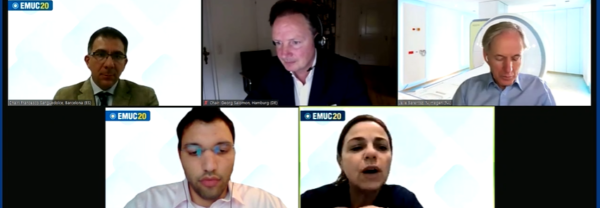ESUI18: Prospects and impact of emerging imaging technologies
The rise of artificial intelligence, imaging-related toxicities, and other cutting-edge topics were featured during the session at ESUI18.
The rise of artificial intelligence, imaging-related toxicities, and other cutting-edge topics were featured during the session “Back to the future part I: What to expect in the next decade?”, which was moderated by Prof. Dr. Jurgen Futterer (NL), Prof. Massimo Mischi (NL), and Prof. Dr. Hessel Wijkstra (NL).
In his lecture, “Rise of the machines – will machines be more precise in image reading: A future perspective”, Dr. Ruud Van Sloun (NL) illustrated the rise of artificial intelligence (AI) and its relation to Deep Learning. Deep Learning is a subset of machine learning where artificial neural networks, algorithms inspired by the human brain, learn from large amounts of data. Examples of this include Google’s search-by-image feature, and Facebook’s “DeepFace” facial recognition software.
“What are we currently doing with regard to artificial intelligence (AI) for ultrasound in our lab? We’re working on fast and reliable automation processes that are usually time-consuming, and that can be done by a machine; improved imaging; and transparent interpretation. It’s not just the machine that says ‘this is the answer’ but also provides you information as to why to give you the chance to interpret the findings,” stated Van Sloun. “Instead of having the AI state that it sees something suspicious in an ultrasound image, we hope it’ll be able to say ‘My advice/decision regarding this suspicious area is based on the following characteristics.’”
Image-related toxicity
A serendipitous and apt timing for radiologist Dr. Pieter De Visschere (BE) to present his lecture “Image related toxicity: What you need to know!” as today is the International Day of Radiology. In his lecture, he covered four topics: Radiation, contrast, MRI-specific injuries, and incidental lesions.
Radiation
He cited the findings of his team’s study “A low dose computed tomography protocol for stone disease can be achieved in two easy steps: results of an internal audit”: “By changing only kilovoltage (kV) and reference milliampere-second (mAs) in the settings of the CT scan protocol, a reduction in delivered dose of nearly 60% could be achieved in patients scanned for renal stone disease. This no-cost protocol without purchasing new software or a new machine.” He also stated, “The most effective way of avoiding radiation is to use MRI or ultrasound.”
Contrast
Similar adverse reactions are seen in Iodine-based, Gadolinium-based, Barium and ultrasound contrast agents; but incidence is highest after Iodine-based contrast media and lowest after ultrasound agents.
“Some contrast-related adverse reactions include acute or late adverse reactions (e.g. allergy-like, hypersensitivity, chemotoxic responses); thyrotoxicosis in patients who had Iodine-based contrast; and Nephrogenic systemic fibrosis.”
MRI-specific injuries
Acquisition of MRI images uses strong magnetic fields and radiofrequency coils present possible injuries such as translational force and torque; projectile injury; thermal injury (burns); interactions with electronic devices (e.g. pacemakers); induced electrical currents (may produce painful neurostimulation) and acoustic injury.
Incidental lesions
Dr. De Visschere stated the dangers of incidental tumour findings such as these warrant additional investigations and in many cases, even surgery; and are often seen as something positive but isn’t always the case. He cited a study [Welch H, et al 2018] which concluded that the “risk of kidney removal surgery is higher for people living in a high-scanning region”.
Contrast is not necessary
In his lecture, “Contrast not needed! How to speed up MR time?” Prof. Futterer (NL) enumerated five arguments that support omission of contrast sequences which are the following:
- They [contrast sequences] do not provide a significant diagnostic gain and are therefore useless.
- They generate unjustified extra costs by using a Gadolinium-based contrast agent.
- The risks associated with the injection of this contrast agent are not justified.
- They increase the duration of the examination and make it less accessible.
- The role of dynamic contrast enhanced (DCE) magnetic resonance imaging (MRI) in PI-RADS version 2.0 is limited.
He also stated that the role of dynamic contrast enhanced (DCE) magnetic resonance imaging (MRI) is questionable based on current evidence. “DCE-MRI plays a minor role. Only selected cases in patients who are biopsy-naïve or have negative biopsies before will not benefit from contrast-enhanced MRI. However, if taken into consideration, if you start MRI with the prostate, I advise to use DCE-MRI to help you get feedback from the pathologist.” Prof. Futterer mentioned costs involved, level of experience, artefacts of diffusion-weighted imaging (DWI), and smart algorithms are factors to be considered.
Multiparametric ultrasound (mpUS) as substitute?
“The mpUS study: Will it replace mpMRI?” and the answer is “No, not for now,” said Mr. Christophe Mannaerts (NL). He stated that current preliminary experience in selected centres is compared to broad application in daily practice. “We, in the ultrasound community, need to work hard to bridge this gap. We need to make acquisition quicker, quantified and preferably, in 3D. It’s possible with Shear wave, contrast-ultrasound dispersion imaging (CUDI), contrast-enhanced ultrasound (CEUS). We also need to increase the availability of 3D probes. Furthermore, we have to look into effective and clinically available combinations.” He also pointed out that micro-ultrasound or computerized Transrectal ultrasound (TRUS) should be looked into as well to make these clinically available.
Mr. Mannaerts added, “There is an urgent need for standardization and collaboration in ultrasound from both the academics and the industry, or else we won’t replace MRI. It is crucial to forming standards for ultrasound to diminish variations in interpretation and biopsy targeting. Coming up research strategies is necessary to enable data collection to educate ultrasound operators.”
To know more, access the ESUI18 Resource Centre.



